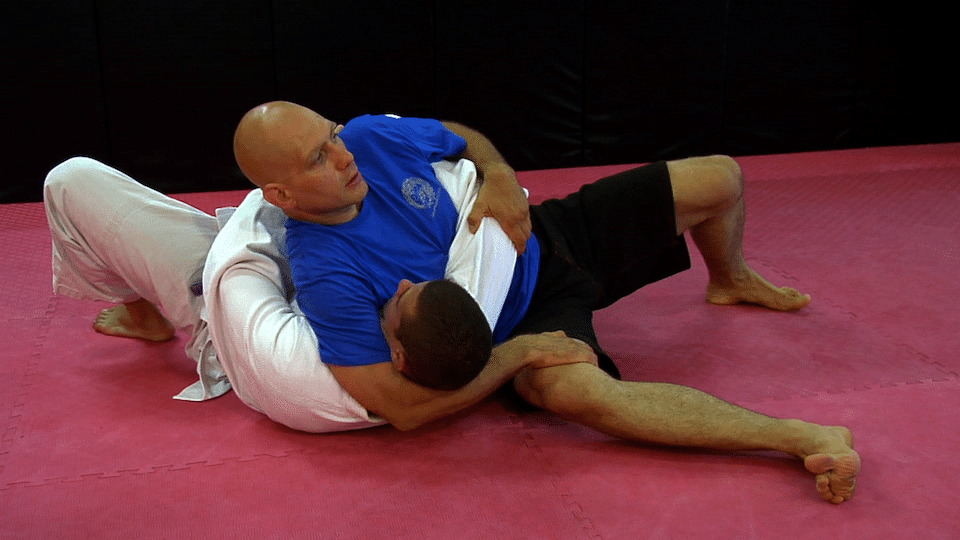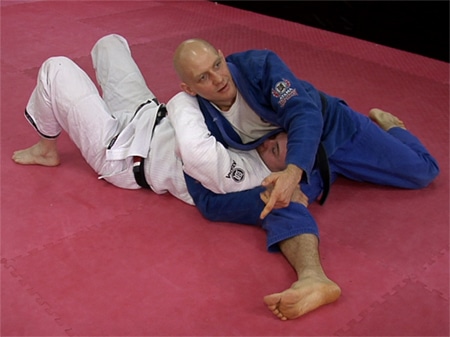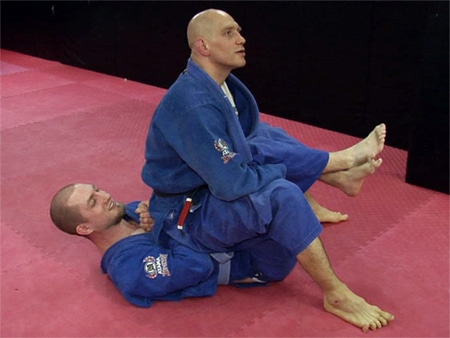There are six major positions in Brazilian jiu-jitsu, Mixed Martial Arts and Submission Grappling. If you learn these positions you’ll be off to a great start, but you’ll also be a bit predictable…
First, let’s review the six basic positions:
- Guard (including closed, open and half guard)
- Sidemount,
- Kneemount,
- Full mount,
- Rear mount,
- Turtle.
These are the bread and butter positions. Everyone who grapples should have a good idea of how to maintain these positions, attack from these positions, and escape from these positions. In fact, that’s exactly why I created the Roadmap for BJJ Package.
BUT I also think that it’s a great idea to go and explore other less-well-known positions.
The topic of unusual positions has been on my mind for the last couple of weeks, because I was getting ready to teach a seminar called “Unorthodox Positions and Attacks” at Dynamic MMA last weekend.
Since I’d never taught this as a distinct topic, I spent a fair bit of time organizing the techniques and strategies I use in these types of positions. I wanted a coherent and teachable curriculum.
Some people will say that you don’t need to go beyond the basic six positions. Other positions – they argue – are merely novelties that distract you from perfecting the basics.
Now I completely agree that perfecting the basics is important – that’s a no brainer. But I also believe that there are at least three important reasons to study positions that aren’t part of regular, normal, day-to-day Brazilian jiu-jitsu.
- First of all, it’s a HUGE advantage to pin an opponent in a position that he’s never seen before. Because he’s unfamiliar with the position, odds are that he won’t know the right way to escape and that he’ll do something stupid, thus giving you the submission. The best part here is that he’ll never see the submission coming.
- Second, being familiar with an odd position is invaluable if YOU get caught in it yourself. If someone puts you into an offside kesa gatame hold then hopefully you’ve been there before, and have some idea of what to do (and what not to do). We are most scared of things we don’t understand.
- Third, you could end up in these unorthodox positions by accident. Strange and convoluted positions happen all the time in grappling. Having a large variety of positions in your grappling rolodex helps you when you end up in something really weird. It’s a huge comfort whenever you’re able to relax and remind yourself that you’ve already been in similar positions.
In the rest of the article we’ll take a look at some of my favorite unorthodox positions, and see how they can be used to give you an unfair advantage in submission grappling and Brazilian Jiu-jitsu. These are the positions featured in my Unorthodox Positions and Attacks DVD, available at Grapplearts.com.
1: Kesa Gatame
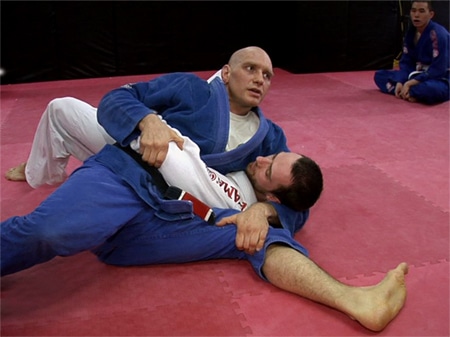
"Kesa Gatame" is the Judo name for this position. It's also known as the Scarf Hold or the Head and Arm pin.
Some people will object my calling Kesa Gatame an ‘unorthodox’ position, because it’s a bread and butter position in Judo, Sambo and Freestyle Wrestling.
That’s true, but even though it may be common in other grappling systems, it’s underutilized and generally frowned upon in BJJ. (I think this is because of the common belief that it’s too easy to have your back taken from here, but that’s easy to counter if you know how).
The thing is: these other arts have honed kesa gatame only as a pinning position. The only problem is that they don’t use or teach very many submissions from here. In those sports the submission is redundant – if you pin your opponent for 3 seconds (wrestling) or 25 seconds (Judo) you win the match. Given these rules, why risk going for a submission?
BJJ is different – the ultimate goal is to submit your opponent, NOT pin him. And if submitting your opponent is your goal, then Kesa Gatame actually has a lot to offer!
I first learned about Kesa Gatame submissions from Shootwrestling, as taught by Dan Inosanto and Erik Paulson. And it turns out that you can submit your opponent using a wide variety of effective submissions, including:
- Straight armlocks
- Bent armlocks
- Chokes
- Neck cranks
- Leglocks
So it should be clear that this is much more than just a pinning position. A grappler with an effective Kesa Gatame can be a submission machine!
Personally I use Kesa Gatame all the time in sparring. It also has a special place in my heart because, many years ago, it saved my butt in a tournament. I was behind on points, managed to secure Kesa Gatame, and then transitioned into a kneebar which won me the gold medal.
So no matter what anybody says, I know that Kesa Gatame works in BJJ.
But that’s NOT just my opinion. Several of my teammates – most notably Benito Segura, now a Marcus Soares brown belt – have refined this into an absolutely deadly position. And yes, I’ve been caught in it. And tapped…
When it comes to Kesa Gatame you don’t necessarily need to make it your primary position, but you’ve GOT to learn a little bit about it.
This is an area of grappling that BJJ and submission grappling people could actually learn a lot from Judo, Freestyle Wrestling, Sambo, Shootwrestling and all the other styles for which Kesa Gatame is a bread and butter position.
2: Offside Kesa Gatame
Here’s another related unorthodox position. I call it the “Offside Kesa Gatame”, because it resembles normal Kesa Gatame except that you’re applying it on the ‘wrong’ side of your opponent’s body.
This position is one of the two variants of Makura Kesa Gatame position in Judo – the main difference is that Judo uses it mainly as a pinning position, but there are a lot of powerful submission options available to you from here!
The first couple of times I ended up in Offside Kesa Gatame was by complete accident! It happened as I was frantically trying to hold down a bucking opponent. At that time I had no clue that I was actually in a position with submission potential. Since then I’ve been formally shown this position by two separate instructors – it’s one of Erik Paulson’s favorites, and also the late Carlson Gracie showed it a seminar he did in Vancouver back in 2005
I can guarantee you that 99% of grapplers caught in Offside Kesa Gatame will be taken completely by surprise. This can give you a huge advantage, because your opponent will often do the wrong thing to get out and give you an easy submission.
When you’re applying Offside Kesa Gatame you trap your opponent’s head and FAR arm (instead of his near arm). His head is elevated off of the ground by resting on your thigh.
The photo at the top of this post shows the positioning of my legs (spread wide) and my right arm (trapping his head and left arm). I’ll tell you more about the positioning of my other arm in a minute…
But first I’ve gotta tell you something very important…
The big danger of Offside Kesa Gatame is getting bridged over backwards. In order NOT to get bridged I normally do TWO things
- I keep my legs spread very wide apart. If your feet are close together then you’re going to go for a ride, straight to the bottom
- I keep my weight forward. That’s why – in the picture just below – my head is down and I’m grabbing my shin with my hand.
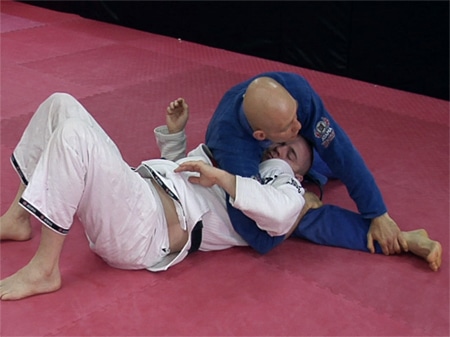
Offside Kesa Gatame fully applied with the weight FORWARD (note how Stephan is leaning forward and grabbing his own shin)
Once you shut down the possibility of getting bridged over backwards he may still manage to escape by squirming, but the chances are that you’ll still be on the top in some variation of side control.
You can slap Offside Kesa Gatame onto your opponent in a number of ways.
The most common entry is probably when you have Side Mount on your opponent with his far arm underhooked. There are other entries as well though – my most recent discovery is how to surprise your opponent by switching to this position from an under-over grip on this back when you don’t have the hooks in yet.
Once you’re in Offside Kesa Gatame there are a variety of very effective armlocks and chokes available to you, most of which keep you in the top position.
As I alluded to earlier you can also end up here completely by accident. Even if you have no intention to make this a bread and butter position, then at the very least you should know how to transition back into a more familiar top position.
So give this position a try. Start with isolating Offside Kesa and work on maintaining it with a semi-cooperative training partner. Then begin incorporating it into your sparring. I think you’ll like the results (but your sparring partners might disagree)!
3: Reverse Mount
The first time I saw the Reverse Mount I was at an Erik Paulson seminar. My reaction was something like “yeah, right….” – I honestly thought that Erik had run out of high percentage things to teach and was now just making stuff up.
Knowing Erik though, I really shouldn’t have doubted him…
As soon as I used the reverse mount in sparring I realized that my opponent had no clue about what to do. In addition, the pressure on his diaphragm turned out to be quite intense, making it hard for him to breath.
This is an application of choking your opponent’s diaphragm instead of his neck. In general, Difficulty breathing = panic = doing something stupid = easy submission! I finished my partner with a submission and that was the beginning of a beautiful relationship.
After that I started using it fairly regularly. I even won the a BJJ tournament with it: I started in North South, jumped up and forward to get to Reverse Mount, and then sunk in a kneebar (a breakdown of that finish, and a video of it, made it into my Dynamic Kneebars DVD).
It’s funny, before you identify something as a position it just looks like a wacky tangle of legs and arms. You think to yourself “how could I ever end up in that silly position?” But after you isolate a position and give it a name you start seeing it much more often. Grapplers may not intend to end up there, but they do anyway.
And you see this position even at the highest levels: I remember watching two top ranked fighters in Pride end up in this position and stalemate there for what seemed like hours (in reality it was probably only a few minutes).
It’s so unusual that the vast majority of people trapped on the bottom have no idea how to escape from here or even what kind of submissions to expect. For you I’ll spill the beans and tell you that most of the attacks from here involve leglocks, but don’t tell anyone…
Knowing how to apply a few so-called ‘specialty’ positions can be an absolute ace up your sleeve!
If you missed the seminar you can still access to the information.
These positions, and the associated entries, submissions and transitions are covered in detail in the Unorthodox Positions and Attacks Package. It contains over 30 entries, submissions and concepts that you can add to your game right away!
Click here for more information!
The post Unorthodox Positions and Attacks appeared first on Grapplearts.

